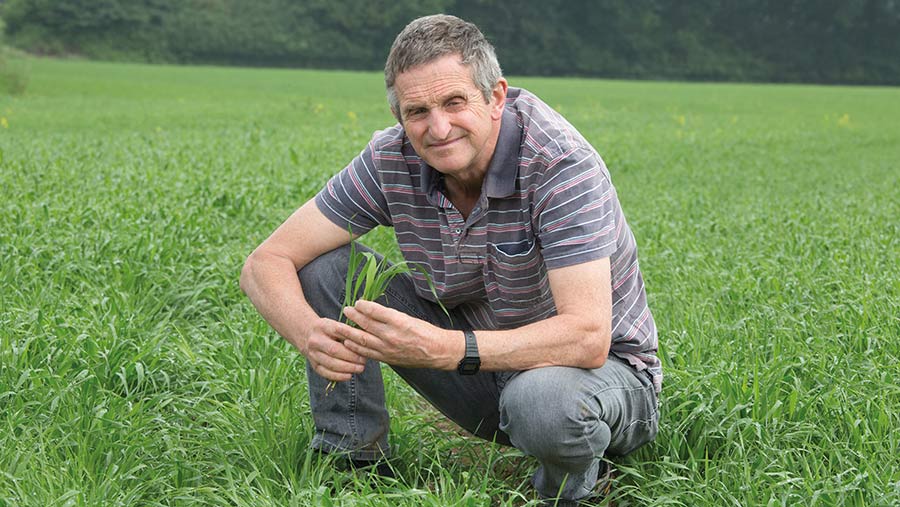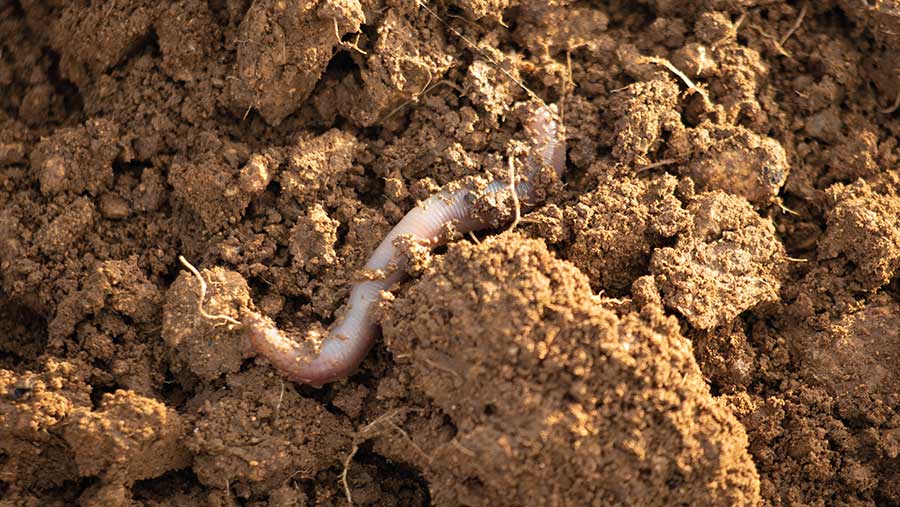How this arable farm became carbon negative and cut costs
 Simon Beddows © Tim Scrivener
Simon Beddows © Tim Scrivener Twenty-five years ago, when the term “net zero” was barely known, south Oxfordshire farm manager Simon Beddows unknowingly began his carbon-cutting journey when he took the plunge to reduce cultivations across his arable enterprise.
At a time when prices were falling and costs were on the rise, Mr Beddows decided to ditch the plough at Dunsden Green Farm in a bid to save on fuel and labour costs.
At the time he didn’t know this would indirectly reduce his carbon footprint, but he still believes implementing carbon-cutting measures makes sound business sense.
See also: How to build a Johnson-Su bioreactor to produce your own on-farm biology
Increased efficiency
Mr Beddows has now achieved a carbon-negative status of 3,031.62t carbon dioxide equivalent (CO2e)/year, and has taken part in the Yield Enhancement Network (Yen) Zero project.
He is also one of five UK farmers to join a carbon initiative run by agrochemical and seeds firm Bayer, which aims to increase soil organic matter by reducing tillage and cover cropping.
He says cutting carbon output can improve farm efficiency, which is why he advises farmers to think about how they can lower costs, which ultimately reduces carbon levels.
“Start with the easy things you can control, such as machinery and fertiliser. Ask yourself if you can cut back on the number of passes or find other ways to reduce fuel and fertiliser use.
“This offers an opportunity for farmers to tackle the unprecedented cost rises which we face. After all, you can’t be green when you’re in the red,” he says.
Cultivation cuts
Growing milling wheat, winter barley, spring barley, oats, oilseed rape and forage maize, Mr Beddows now operates a minimum-tillage operation and is improving soil organic matter levels by using cover cropping and farmyard manure.
He explains that building soil organic matter levels has the greatest effect on carbon footprint offsetting, and contributes just over 77% of emission offsets on the 1,000ha farm, north-east of Reading.
Furthermore, the removal of deep and intensive cultivations has helped build organic matter and saved significant amounts of fuel.
Ploughing, cultivating and drilling uses 40.3 litres/ha of fuel, while shallow cultivation, followed by drilling with a Kockerling tine drill, uses 15.4 litres/ha – a significant saving of 24.9l/ha, with a lower carbon footprint.
Where cover crops are introduced ahead of spring cropping, using a direct drill for both the cover and following cereal crop an additional 1.5 litre/ha is used over the min-till system.
This is because of the extra sowing and rolling passes needed for the cover crop.
Soil health
The switch from a 350hp tractor to a 200hp machine removed 13t of weight from across the fields, helping reduce compaction. This has done soil health a world of good.
“Since reducing the number and depth of cultivations, the system works really well, but it’s important to be flexible.
“We don’t always direct-drill – sometimes we cultivate to a couple of inches. And when we grow maize silage for a local beef farmer we work at a much deeper depth.
“So we, in effect, have a cultivation rotation working to different depths.
“We also have a range of soil types, from fertile loams to clay and gravel. Wheat yields therefore vary from 7t/ha to 11t/ha, with 17 different soil types present in one 40ha block,” he says.

© Tim Scrivener
Despite not ploughing for 20 years, an invasion of rat’s tail fescue across one block of land prompted Mr Beddows to use the plough to tackle the weed burden.
He suspects the influx was the result of a patchy winter linseed crop, which allowed the weed to take hold.
“After ploughing we planted spring barley, which will be followed by a two-year legume break crop under a Countryside Stewardship scheme [AB15], after which we will bring it back into arable cropping,” he says.
Carbon sale risks
Having this cultivation flexibility is key to tackle the ever-changing issues farming throws at you. This is why Mr Beddows is cautious when it comes to selling carbon credits, as it could restrict certain farming practices.
“There is a risk with selling carbon credits too far ahead that we could sell ourselves down the river. What happens if we need to plough due to a weed issue, but we no longer can as we have sold our carbon credits?”
He warns growers not to sign up for long-term carbon agreements and seek legal advice before entering into any agreements.
Carbon audit at Dunsden Green Farm
Using the Farm Carbon Calculator, grower Simon Beddows undertook a full carbon audit of his 1,000ha arable enterprise.
The whole farm was found to have an overall negative carbon footprint of 3,031.62t of carbon dioxide equivalent (CO2e)/year.
However, Mr Beddows admits this was only achieved by using an average organic matter content of 4.5% based on a limited number of soil tests across the farm.
The original footprint was in fact +1,287t CO2e/year.
The adjusted calculation was composed of a total 2,462t of CO2e emitted, while 5,493t of CO2e was offset.
Emissions included machinery, fuel, electricity, buildings, crop inputs and water.
Any buildings and machinery less than 10 years old are accounted for within the carbon footprint, while anything older than this is not.
When calculating how much carbon has been sequestered, the tool accounts for the amount of habitats, hedgerows, woodland, soil organic matter and crop yield.
“When using carbon calculators be sure to use the same software each time for your calculations for the results to be comparable as there is an array of different calculators out there on the market,” he says.
Carbon audit results |
||
|
Emissions |
Carbon dioxide equivalent emitted (t) |
Percentage (%) |
|
Fuel |
262.50 |
10.66 |
|
Materials |
744.74 |
30.25 |
|
Inventory |
105.07 |
4.27 |
|
Crops |
552.68 |
22.45 |
|
Inputs |
797.08 |
32.37 |
|
Total |
2,462.08 |
100% |
|
Offset |
||
|
Habitats |
-190.99 |
3.48 |
|
Hedgerows |
-114.94 |
2.09 |
|
Soil organic matter |
-4250.21 |
77.37 |
|
Woodland |
-877.76 |
15.98 |
|
Other (such as recycling) |
-59.80 |
1.09 |
|
Total |
-5,493.70 |
100% |
Yen Zero project
The Yen Zero project provides a detailed assessment of greenhouse gas emissions and subsequent carbon footprint associated with farming operations.
Spring malting barley emissions at Dunsden Green Farm were well below the UK average of 2,100kg CO2e.This was mostly likely because of the reduced amount of nitrogen applied at just 110kg/ha.
Synthetic nitrogen manufacturing and its application are the biggest contributors to greenhouse gas emissions on arable farms at 64%, and so plays a significant role in a farm’s carbon footprint.
Simon Beddows’ next step is to cut back the nitrogen levels of his milling wheats to further reduce emissions.
Wheats normally receive 260kg N/ha, but this season he is setting up tramline trials to identify how much he can trim back rates, testing rates of 100kg, 150kg and 180kg/ha. However, if cutting back N affects quality too much, he questions whether he will continue to grow milling wheat at all.
Yen Zero crop emissions at Dunsden Green Farm |
||||
|
Field |
Crop |
Variety |
Yield (t/ha) |
Greenhouse gas emissions (kg CO2e/ha) |
|
1 |
Spring barley (malting) |
Planet |
5.6 |
1,400 |
|
2 |
Spring barley (malting) |
Planet |
4.8 |
1,330 |
|
3 |
Winter wheat (milling) |
Zyatt |
11.3 |
3,191 |
|
4 |
Winter wheat (milling) |
Zyatt |
9.1 |
3,051 |
|
5 |
Winter barley (feed) |
Rafaela |
6.7 |
2,343 |
|
6 |
Winter linseed |
Alpaga |
1.2 |
1,885 |

